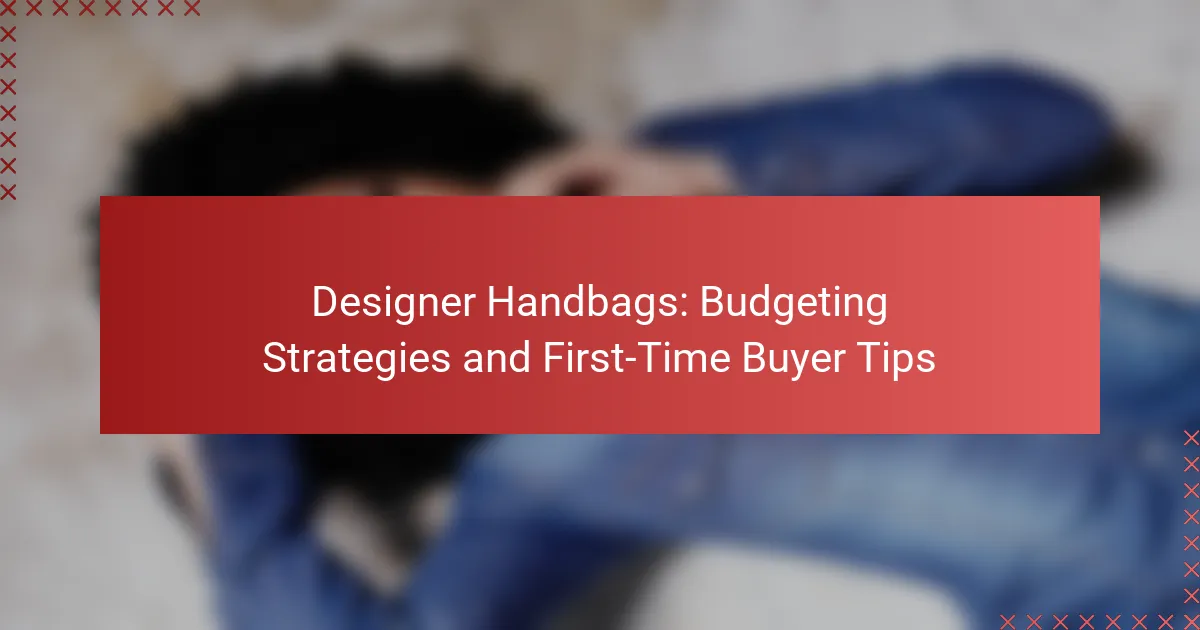Investing in a designer handbag can be a rewarding experience, but it requires careful budgeting and informed decision-making. By setting aside a monthly savings goal and prioritizing your purchases, you can indulge in luxury without financial strain. For first-time buyers, focusing on classic styles, understanding brand reputation, and verifying authenticity are crucial steps to ensure a satisfying purchase.

How to budget for designer handbags?
Budgeting for designer handbags involves setting aside a specific amount each month to save for your desired items. By planning your finances and prioritizing your purchases, you can enjoy luxury items without overspending.
Set a monthly savings goal
Establishing a monthly savings goal is crucial for effective budgeting. Determine how much you can comfortably set aside each month without impacting your essential expenses. A common approach is to aim for a specific percentage of your income, such as 10-15%.
For example, if you aspire to buy a handbag costing around $1,200, setting aside $100 monthly would allow you to reach your goal in about a year. Adjust your savings goal based on your timeline and financial situation.
Research average prices
Understanding the average prices of designer handbags helps you set realistic expectations. Prices can vary significantly based on brand, style, and materials, often ranging from a few hundred to several thousand dollars.
Spend time researching online retailers, brand websites, and luxury consignment shops to gauge typical price points. This knowledge will assist you in identifying a budget that aligns with your desired handbag.
Prioritize purchases
Not all designer handbags are created equal; some may hold more value or appeal to you than others. Prioritize your wishlist based on factors such as brand reputation, versatility, and resale value.
Consider creating a tiered list: top-tier items that you want most, mid-tier options that are nice to have, and lower-tier bags that are more of a luxury. This will help you focus your savings efforts on the handbags that matter most.
Consider pre-owned options
Buying pre-owned designer handbags can significantly reduce costs while still allowing you to enjoy luxury brands. Many pre-owned bags are in excellent condition and can be found at a fraction of the original price.
Explore reputable consignment shops and online platforms specializing in pre-owned luxury items. This option not only saves money but also promotes sustainability in fashion.
Use budgeting apps like Mint
Utilizing budgeting apps like Mint can streamline your financial planning for designer handbag purchases. These apps allow you to track your spending, set savings goals, and monitor your progress in real-time.
By categorizing your expenses and visualizing your savings, you can make informed decisions about your handbag budget. Regularly reviewing your financial habits through these apps can help you stay on track and adjust your goals as needed.

What are the best first-time buyer tips for designer handbags?
First-time buyers of designer handbags should focus on making informed choices to ensure a satisfying purchase. Key strategies include selecting classic styles, understanding brand reputation, shopping during sales, verifying authenticity, and reading customer reviews.
Choose classic styles
Selecting classic handbag styles is a smart strategy for first-time buyers. Timeless designs, such as the Chanel Classic Flap or the Louis Vuitton Speedy, tend to retain their value and appeal over time. These styles are versatile and can complement various outfits, making them a worthwhile investment.
When considering classic styles, think about your personal wardrobe and lifestyle. Opt for neutral colors like black, beige, or navy, which can easily match different ensembles. This approach not only enhances your fashion choices but also increases the longevity of your handbag.
Understand brand reputation
Researching brand reputation is crucial when purchasing a designer handbag. Established brands like Gucci, Prada, and Hermès are known for their quality and craftsmanship, which can justify higher price points. Familiarizing yourself with a brand’s history and customer service can help you make a more confident decision.
Look for brands that have a strong presence in the luxury market and positive reviews from customers. Avoid lesser-known brands that may compromise on quality or authenticity. A reputable brand often signifies a better resale value, should you choose to sell the handbag later.
Shop during sales events
Taking advantage of sales events can significantly reduce the cost of designer handbags. Major sales periods, such as Black Friday, Cyber Monday, and end-of-season sales, often feature discounts on luxury items. Signing up for newsletters from your favorite brands can keep you informed about upcoming promotions.
Consider outlet stores or authorized retailers that offer seasonal sales. These venues can provide access to authentic designer handbags at lower prices, making it easier to stick to your budget while still acquiring a high-quality piece.
Verify authenticity
Ensuring the authenticity of a designer handbag is essential to protect your investment. Always purchase from reputable retailers or directly from the brand to minimize the risk of counterfeit products. Look for authenticity cards, serial numbers, and high-quality materials as indicators of a genuine item.
Familiarize yourself with the specific details of the handbag you wish to buy, such as stitching patterns and hardware quality. If buying pre-owned, consider using authentication services that specialize in luxury goods, providing an extra layer of assurance before completing your purchase.
Read customer reviews
Customer reviews can provide valuable insights into the quality and functionality of designer handbags. Look for feedback on the handbag’s durability, comfort, and overall satisfaction from previous buyers. This information can help you gauge whether a particular model meets your expectations.
Utilize online platforms and social media to gather diverse opinions. Pay attention to recurring themes in reviews, such as common issues or standout features. This research can guide you toward making a more informed decision and avoiding potential pitfalls in your purchase.

Where to buy designer handbags online?
To buy designer handbags online, you can explore various platforms that cater to luxury fashion. These include official brand websites, luxury e-commerce platforms, consignment stores, and social media marketplaces, each offering unique advantages and selections.
Visit official brand websites
Official brand websites are often the best place to start when looking for designer handbags. They provide the latest collections, exclusive releases, and authentic products directly from the brand. Shopping here ensures you receive genuine items and often access to brand-specific promotions.
When browsing these sites, look for seasonal sales or special offers that can help you save money. Additionally, many brands offer loyalty programs that reward repeat customers with discounts or early access to new products.
Explore luxury e-commerce platforms
Luxury e-commerce platforms like Farfetch, Net-a-Porter, and MyTheresa curate a wide range of designer handbags from various brands. These platforms often feature competitive pricing and exclusive items not available elsewhere. They also provide user-friendly interfaces and detailed product descriptions.
Be aware of shipping costs and return policies, as these can vary significantly between platforms. Some may offer free shipping over a certain amount, while others might charge fees that could affect your budget.
Check out consignment stores
Consignment stores, both online and physical, offer pre-owned designer handbags at reduced prices. Websites like The RealReal and Vestiaire Collective specialize in authenticated second-hand luxury items, allowing you to find unique pieces at a fraction of the original price.
When purchasing from consignment stores, check the condition of the handbag and ensure it comes with proper documentation. This can help you avoid counterfeit items and ensure you are making a worthwhile investment.
Utilize social media marketplaces
Social media marketplaces, such as Facebook Marketplace and Instagram shops, have become popular for buying and selling designer handbags. These platforms allow users to connect directly with sellers, often leading to better deals and unique finds.
However, exercise caution when purchasing through social media. Always verify the seller’s credibility, request additional photos, and consider using secure payment methods to protect yourself from potential scams.

What are the key features to look for in designer handbags?
When selecting a designer handbag, focus on material quality, brand craftsmanship, size and functionality, and resale value. These elements significantly impact the bag’s durability, style, and long-term investment potential.
Material quality
High-quality materials are essential for a designer handbag, as they determine the bag’s longevity and appearance. Look for leather types such as full-grain or top-grain, which are known for their durability and rich texture. Other materials like canvas or nylon can also be high-end, especially when used by reputable brands.
Check for details like stitching and lining; well-constructed bags often feature reinforced seams and premium linings that enhance both aesthetics and durability. Avoid bags with visible flaws or inconsistent textures, as these may indicate lower quality.
Brand craftsmanship
The craftsmanship of a designer handbag reflects the brand’s reputation and attention to detail. Renowned brands often employ skilled artisans who ensure that each bag is meticulously crafted. Look for features such as even stitching, precise hardware placement, and smooth zippers, which indicate a high level of craftsmanship.
Research the brand’s history and customer reviews to gauge their commitment to quality. Brands with a long-standing reputation for excellence are more likely to produce handbags that stand the test of time.
Size and functionality
Consider the size and functionality of the handbag to ensure it meets your needs. Assess whether you prefer a compact bag for essentials or a larger tote for daily use. Many designer handbags come in various sizes, so choose one that fits your lifestyle.
Functionality is equally important; look for features like adjustable straps, multiple compartments, and secure closures. These elements enhance usability and can make a significant difference in your daily routine.
Resale value
Resale value is a crucial factor when investing in a designer handbag. Certain brands and styles tend to retain or even appreciate in value over time, making them more desirable for future resale. Research popular models and limited editions that have historically performed well in the resale market.
Keep in mind that maintaining the bag’s condition is vital for preserving its resale value. Store it properly, avoid excessive wear, and keep original packaging and receipts to maximize potential returns when selling.
